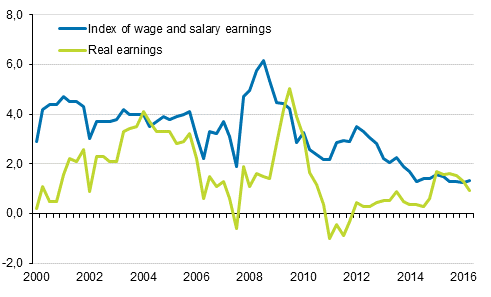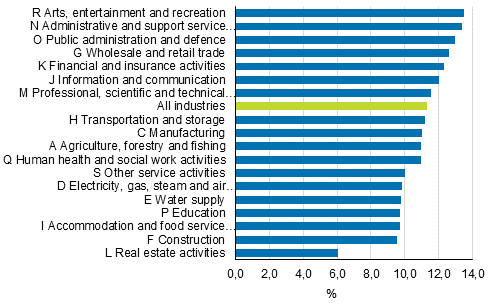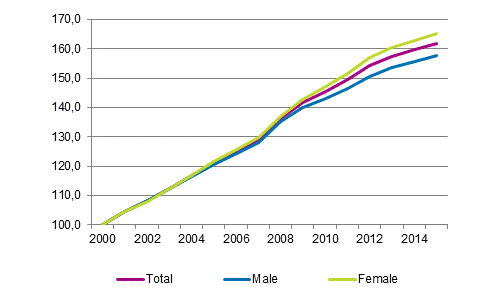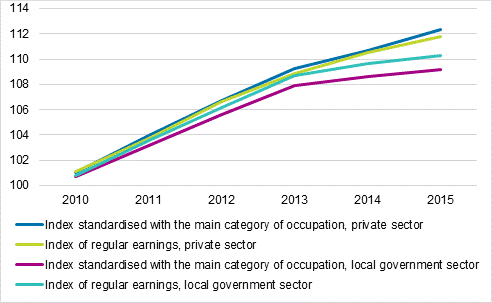Published: 25 August 2016
Wage and salary earners' earnings rose by 1.3 per cent in April–June
New paragraph added on 25 August at 10:00. The added paragraph is indicated in red.
According to preliminary data of Statistics Finland, the nominal earnings of wage and salary earners rose by 1.3 per cent in April–June 2016 when compared to the respective period in 2015. Real earnings rose by 0.9 per cent compared to the second quarter of the previous year.
Year-on-year changes in index of wage and salary earnings 2000/1–2016/2, per cent

During the period from April–June 2015 to the respective period in 2016 the nominal earnings of wage and salary earners rose in the private sector by 1.3 per cent, in the central government sector by 2.0 per cent and in the local government sector by 1.2 per cent.
Wage and salary earners' regular earnings increased by 1.3 per cent in April–June
Wage and salary earners' regular earnings refer to earnings for regular working hours exclusive of performance-based bonuses and other irregularly paid one-off items. Wage and salary earners' regular earnings rose by 1.3 per cent in April–June 2016 when compared to the respective period in 2015. The increase was 1.3 per cent in the private sector, 2.0 per cent in the central government sector and 1.2 per cent in the local government sector.
According to preliminary data are wage and salary earners’ earnings in July–September 1.1 per cent higher than in the previous year
According to preliminary data of Statistics Finland, the nominal earnings of wage and salary earners rises by 1.1 per cent in July–September 2016 when compared to the respective period in 2015. According to preliminary data, the index of wage and salary earnings 2010=100 for the third quarter of 2016 is 112.7. Statistics Finland compiles the preliminary data of the index of wage and salary earnings for the third quarter on the basis of the Employees Pensions Act (2006/395).
Earnings development varies by industry
The indices of wage and salary earnings and the indices for regular earnings are final until 2015. They are based on the realised earnings development. The indices for 2016 are preliminary and they are based on estimates of agreement effects and the wage drift.
In 2015, earnings rose most in manufacturing, by 2.1 per cent. Earnings decreased in real estate activities by 0.9 per cent. The rise in manufacturing was, for example, impacted by a rise in the earnings of monthly wage earners within the wood and metal industries. In these industries, performance-based bonuses increased in 2015.
The figure shows the percentage change in the index of wage and salary earnings on the level of main activity categories in 2010 to 2015. Earnings development has been briskest in arts, entertainment and recreation (13.5 per cent) and in administrative and support service activities (13.4 per cent). Earnings development has been slowest in real estate activities, where earnings have risen by six per cent in 2010 to 2015.
Changes in the index of wage and salary earnings 2010=100 by industry (TOL2008) in 2010 to 2015

Development of the index of wage and salary earnings by gender
The index of wage and salary earnings describes the development in the average earnings of full-time wage and salary earners. Measured by the index of wage and salary earnings, women's earnings have risen slightly faster than men's in the 2000s.
The figure shows the development of women's, men's and all wage and salary earners’ index of wage and salary earnings. Women’s index of wage and salary earnings has developed faster and men's more slowly than the index of all wage and salary earners. In 2015, women’s index of wage and salary earnings 2000=100 was 165.1 and men’s 157.7. The index for all wage and salary earners’ was 161.9.
Development of the index of wage and salary earnings by gender in 2000 to 2015, 2000=100

Measured in euro, women's earnings are on average smaller than men’s. Women's earnings have, however, developed more quickly than men's during the 2000s.
Change in occupational structure affects the development of average earnings
Statistics Finland has since 2013 published the index standardised with the main category of occupation based on the data of the index for regular earnings. In the index, the shares of the main categories of occupation for each wage and salary earner group are standardised based on the wage and salary sum weights of 2010.
The figure shows the development of the index for regular earnings and the index standardised with the main category of occupation in 2010 to 2015. The last quarter of the year has been selected for the examination and it starts from 2010 because earnings development data standardised with the category of occupation are available starting from 2010. The development of the index standardised with the main category of occupation has been slower in the 2010s in the local government sector than the development of the index for regular earnings. In the private sector, the index standardised with the main category of occupation has developed slightly faster than the index for regular earnings. However, the difference between the indices is not as clear as in the local government sector.
Development of the index standardised with the main category of occupation and the index for regular earnings in 2010 to 2015 in the local government sector and in the private sector, 2010=100

In the local government sector, the development indicates that the rise in average earnings has been boosted by the change in the occupational structure. In higher occupational groups, wage and salary earners usually have a higher university degree, and in these occupations the earnings level is also higher than average. An increased share of higher occupational groups within an employment sector boosts the rise in earnings in the sector in question. In lower occupational groups, the earnings level is lower than the average earnings level. An increased share of these occupational groups within an employment sector slows down the rise in earnings in the sector in question.
For instance, the share of professionals among all local government employees has slightly increased and the share of service and sales workers has decreased in the 2010s. This means that the increase in the average earnings in local government is higher than the average pay increases. This is because the earnings level of professionals is higher than the average earnings level in the local government sector and the earnings level of service and sales workers is lower.
The development in the central government sector has been similar to the local government sector. In higher occupational groups, especially the share of professionals among all central government employees has increased in the 2010s. In lower occupational groups, the share of clerical support workers has decreased.
In the private sector, the share of managers has declined slightly and the share of service and sales workers has increased in the 2010s. The fall in the share of managers means the rise in average earnings in the private sector has slowed down. Correspondingly, the increase in the share of service and sales workers has also slowed down the rise in average earnings in the private sector because the earnings level of service and sales workers is lower than the average earnings level in the private sector. Because the research data concern a short period, it is not possible to draw any conclusions based on them on the long-term effects of the change in occupational structure in the private sector.
Publishing of the index standardised with the main category of occupation is one way to illustrate the effects of structural changes on general earnings development and in sector-specific comparisons such as comparisons between employer sectors.
Source: Index of wage and salary earnings 2016, 2nd quarter. Statistics Finland
Inquiries: Anu Uuttu 029 551 2322, Harri Nummila 029 551 3235, palkat.indeksit@stat.fi
Director in charge: Mari Ylä-Jarkko
Publication in pdf-format (488.8 kB)
- Tables
-
Tables in databases
Pick the data you need into tables, view the data as graphs, or download the data for your use.
Appendix tables
- Appendix table 1. Index of wage and salary earnings 2010=100 by employer sector and base of payment (25.8.2016)
- Appendix table 2. Index of regular earnings 2010=100 by employer sector and base of payment (25.8.2016)
- Appendix table 3. Index of wage and salary earnings 2010=100 by employer sector and gender (25.8.2016)
- Appendix table 4. Index of regular earnings 2010=100 by employer sector and gender (25.8.2016)
- Appendix table 5. Index of wage and salary earnings 2010=100 by industry, (TOL 2008) (25.8.2016)
- Appendix table 6. Index of regular earnings 2010=100 by industry, (TOL 2008) (25.8.2016)
- Appendix table 7. Index of wage and salary earnings 2005=100 by employer sector and gender (25.8.2016)
- Appendix table 8. Index of wage and salary earnings 2005=100 by industry, (TOL 2008) (25.8.2016)
- Appendix table 9. Index of wage and salary earnings 2010=100, percentage changes (25.8.2016)
- Appendix table 10. Index of regular earnings 2010=100, percentage changes (25.8.2016)
- Appendix table 11. Average earnings by employer sector and gender, EUR/month (25.8.2016)
- Revisions in these statistics
-
- Revisions in these statistics (25.8.2016)
Updated 25.08.2016
Official Statistics of Finland (OSF):
Index of wage and salary earnings [e-publication].
ISSN=1798-7814. 2nd quarter 2016. Helsinki: Statistics Finland [referred: 21.12.2025].
Access method: http://stat.fi/til/ati/2016/02/ati_2016_02_2016-08-25_tie_001_en.html

